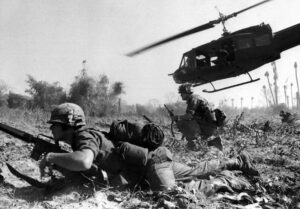I entered Virginia Military Institute as a freshman in 1968. By that time, the Vietnam War was in full swing. During the four years that I was at the school, VMI graduates were among the tens of thousands of U.S. soldiers who were being killed or injured for nothing.
Everyone at VMI was required to be in the corps. Naturally, as a military school, we would periodically have field training exercises, which usually were supervised and run by military officers in the military-science department.
 Since I was going into army infantry, my field training exercises were based on hypothetical situations entirely involving Vietcong or North Vietnamese forces.
Since I was going into army infantry, my field training exercises were based on hypothetical situations entirely involving Vietcong or North Vietnamese forces.
For example, we would be told that a North Vietnamese unit was known to use a particular path through the jungle. Our mission, as platoon leaders, was to prepare an ambush of the unit employing our three squads. (We were trained to align all three squads on the same side so that they wouldn’t be firing at each other.)
This went on for four years. All of the field training exercises — without exception — were based on hypothetical situations involving Vietcong and North Vietnamese forces.
During the year I graduated — 1972 — President Nixon began withdrawing U.S. troops from Vietnam. I was offered the option of trading a two-year active-duty commitment for an 8-year commitment in the Reserves, which included 3 months of active duty attending infantry school at Ft. Benning, Georgia. I readily accepted the offer.
In 1974, I temporarily dropped out of law school to fulfill my 3-month commitment. By this time, it was clear that the U.S. government was completely leaving the Vietnam War behind.
Of course, I was wondering what they were going to do with those field-training exercises. They didn’t skip a beat. From Day 1 of infantry school, they had a brand new official enemy that became the subject of infantry training. That new official enemy was the Russians.
The training hypotheticals now involved conventional warfare rather than guerrilla warfare. For example, the hypothetical would say that Russian forces have suddenly invaded West Germany. We’d be required to plan an ambush of a Russian force in a German forest.
Even though I had not yet discovered libertarianism, I marveled at the ability of the military to so quickly and seamlessly shift official enemies from the “gooks” to the Russkies. For four years at VMI, no one had ever used the Russkies as an official enemy in our field training exercises and now, suddenly, they had become a big, official enemy.
Of course, no one asked any questions about this. It was all considered to be perfectly normal. It also doesn’t pay to ask those types of questions in the military.
After I discovered libertarianism, I learned that that’s what life is like under a national-security state. A national-security state always needs official enemies in order to justify its existence and its ever-growing taxpayer-funded largess. Without official enemies, Americans might start considering the dismantling of the national-security state and the restoration of their founding governmental system of a limited-government republic.
Consider how quickly the national-security establishment came up with a new official enemy after it suddenly lost Russia as its official enemy when the Cold War ended. Saddam Hussein, the dictator of Iraq, who ironically had been a partner and ally of the U.S. government, was branded as a “new Hitler.” For more than a decade, he was used as the new official enemy. Taxpayer-funded largess flooded into the coffers of the Pentagon, the military-industrial complex, the CIA, and the NSA to protect us from Saddam and his (nonexistent) WMDs.
After terrorists retaliated for the U.S. government’s interventionist antics in the Middle East, the “terrorists” (or the Muslims) became the new official enemy. The “war on terrorism” became as lucrative as the 45-year “war on the Reds.” Moreover, the U.S. invasions and occupations of Afghanistan and Iraq ensured a constant stream of new terrorists. The “war on terrorism” racket went on for 20 years and, actually, isn’t completely over.
What is absolutely fascinating is how they were able to go so quickly from the exit debacle in Afghanistan to a new (sort of) official enemy — Russia, with its invasion of Ukraine. Why, there wasn’t even enough time to engage in even superficial soul-searching about their catastrophic wars in Afghanistan and Iraq!
What the Pentagon had been doing, of course, during the entire time it was occupying Afghanistan and Iraq was hedging its bets by using NATO to expand eastward toward Russia. The idea was that if Afghanistan and Iraq began fizzling out, the Pentagon would be able to make Russia an official enemy again.
The scheme worked brilliantly. With Russia’s invasion of Ukraine, in response to NATO’s antics, the U.S. national-security establishment was off to the races again, with its taxpayer-funded largess now approaching $1 trillion. If Ukraine starts to fizzle out, there is also Red China. Maybe North Korea too. For that matter, a few years from now, maybe they’ll figure out a way to restart their “war on terrorism” racket.
I entered VMI more than 50 years ago. As we can see, things haven’t changed a bit.

